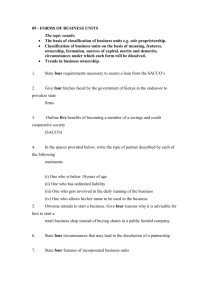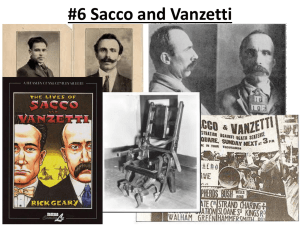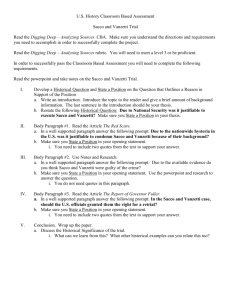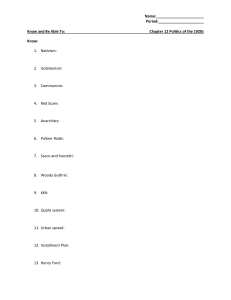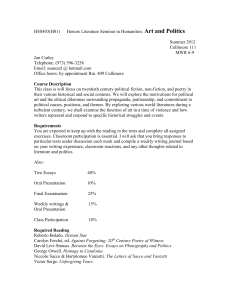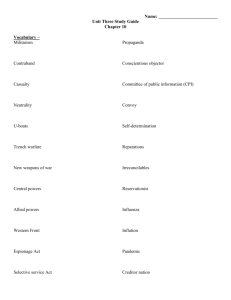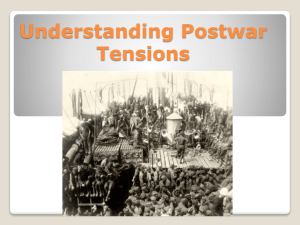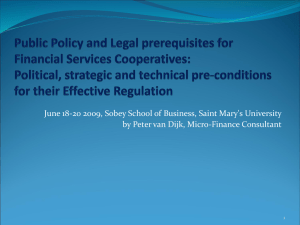The Reception of Joe Sacco's Palestine
advertisement
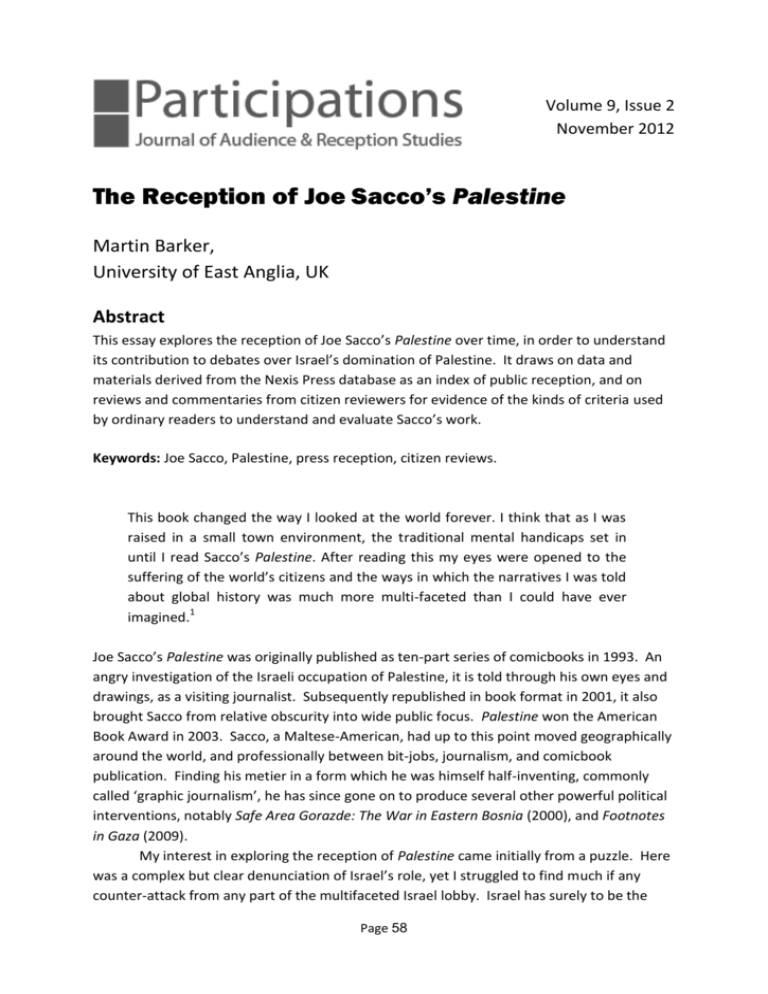
. Volume 9, Issue 2 November 2012 The Reception of Joe Sacco’s Palestine Martin Barker, University of East Anglia, UK Abstract This essay explores the reception of Joe Sacco’s Palestine over time, in order to understand its contribution to debates over Israel’s domination of Palestine. It draws on data and materials derived from the Nexis Press database as an index of public reception, and on reviews and commentaries from citizen reviewers for evidence of the kinds of criteria used by ordinary readers to understand and evaluate Sacco’s work. Keywords: Joe Sacco, Palestine, press reception, citizen reviews. This book changed the way I looked at the world forever. I think that as I was raised in a small town environment, the traditional mental handicaps set in until I read Sacco’s Palestine. After reading this my eyes were opened to the suffering of the world’s citizens and the ways in which the narratives I was told about global history was much more multi-faceted than I could have ever imagined.1 Joe Sacco’s Palestine was originally published as ten-part series of comicbooks in 1993. An angry investigation of the Israeli occupation of Palestine, it is told through his own eyes and drawings, as a visiting journalist. Subsequently republished in book format in 2001, it also brought Sacco from relative obscurity into wide public focus. Palestine won the American Book Award in 2003. Sacco, a Maltese-American, had up to this point moved geographically around the world, and professionally between bit-jobs, journalism, and comicbook publication. Finding his metier in a form which he was himself half-inventing, commonly called ‘graphic journalism’, he has since gone on to produce several other powerful political interventions, notably Safe Area Gorazde: The War in Eastern Bosnia (2000), and Footnotes in Gaza (2009). My interest in exploring the reception of Palestine came initially from a puzzle. Here was a complex but clear denunciation of Israel’s role, yet I struggled to find much if any counter-attack from any part of the multifaceted Israel lobby. Israel has surely to be the Page 58 Volume 9, Issue 2 November 2012 most financially cosseted and militarily guaranteed nation on the planet, and has two de rigueur lines of defence against ‘detractors’: the raising of Holocaust Guilt; and the charge of anti-Semitism. Usually sharp and determined in its assaults on anything critical of Israeli policy and behaviour, it struck me as curious that I simply had not come across critiques of Sacco’s work. Was this because of the medium in which it was published? Was there something about the way he made his arguments that caused difficulty for the Lobby? Spurred on by my awareness that it was a long time since I had attempted any comicbook-related audience research, but realising that I was currently in no position to mount a project researching actual current audiences, I chose instead to explore traces of Palestine’s reception in reviews, and online debates.2 In this essay I draw on two contrasting bodies of materials to offer answers to the following questions: 1. What patterns can be discerned in the history of Palestine’s reception, notably with respect to its author’s reputation in mainstream media reviews and commentaries? 2. What kinds of debate have accompanied the work in online repositories (where responses are often not so readily datable)? 3. From these, is it possible to discern the qualities that are attended and responded to by those who are most positive about the book (as contrasted with those who are most negative about it), and thence to see what kind of influence it has on their thinking? These questions emerge from the application of a combination of theoretical resources to this topic: reception studies; fan studies; and my own tradition of audience research. I briefly address each in turn: The Reception Studies Tradition After a considerable time as an essentially theoretical tradition born and developed by literary scholars Wolfgang Iser and Hans Robert Jauss, the reader-reception approach turned, most notably in the hands of film scholar Janet Staiger, into a way of asking and answering empirical questions about audiences. Staiger first laid out an overall approach in her Interpreting Films (1992), and then fleshed it out particularly in her Perverse Spectators (2000). The core principles underlying her approach are that the meanings of cultural forms such as films cannot be derived from textual features alone; rather, they are produced in an interaction between those features and the interpretive frameworks which different audiences bring to bear on them. These frameworks will vary by the social, cultural and political positions from which different audiences look and read, but they will also tend to accrete over time, as books, films, plays or whatever carry with them a load and backlog of critical opinion. Staiger particularly uses press reviews as her evidential source for her arguments, and powerfully demonstrates for a wide array of films (from Birth of a Nation, to A Clockwork Orange, and Silence of the Lambs) the operation of a range of interpretive positions. Crucial to her account is the realisation that all critical positions select what they Page 59 Volume 9, Issue 2 November 2012 attend to and attach importance to, and that the results of these selections are in effect ‘different films’. Staiger’s work has been taken forward and indeed widened and deepened by a number of other scholars, among others by Barbara Klinger (whose 1994 work on the history of the reception of Douglas Sirk’s films is exemplary), and Cynthia Erb (1998, who broadened the range of kinds of materials studied, in her study of the reputation of King Kong). And coming from another theoretical source, Robert Kapsis’ (1992) work on Alfred Hitchcock’s reputation works in quite similar ways and arrives at many of the same conclusions. This tradition of work, then, uses materials such as reviews as resources for analysing and capturing the kinds of circulating discursive frameworks and criteria through which evaluations and judgements are made. Fan studies The tradition of work greatly initiated by Henry Jenkins (1992) takes as its starting point that fans of popular media are productive users rather than passive consumers of their favourite materials. They list, catalogue, evaluate, critique, share, add to, parody, and celebrate – among many other activities. And they tend to do this in communities. Fan studies quickly found in the rise of the internet a rich and convenient resource for these studies (see for instance Harris & Alexander, 1998). Many large and small studies followed, of particular communities for particular TV programmes, films. A great emphasis came to be placed over time on the nature of these communities: how people are inducted into them, what ‘rules of participation and exchange’ operate, and how communities evolve over time. Fan studies also seek to draw out the criteria by which fans make judgements, and how this leads them to prefer particular characters, episodes, series, etc, and to reject others as inadequate – but always of course within the frame of continuing fandom. A number of critics of fan studies have argued against what they see an overly celebratory account of these communities, particularly criticising some of Jenkins’ pronouncements where he seems at times to view them as new sites for democratic action, even new modes of cultural intelligence. (For a good overview of many of these developments, see Hills, 2002.) But for the close studies it has fostered into fans’ varying ways of loving their sourcematerials, along with the acute attention it has encouraged towards web-based materials, there is no doubt about the value of fan studies. Audience research For the past twenty five years I have been involved, with many others, in establishing the field of audience research under the broad aegis and influence of the British cultural studies tradition (although there are points of considerable tension with that tradition as well). There are undoubtedly many connections and overlaps with the other two traditions, but they are not identical. And on certain particular issues there are important differences. The cultural studies tradition first focused on the kinds of media that have tended to be Page 60 Volume 9, Issue 2 November 2012 dismissed as ‘trivial’ and ‘mindless’ by cultural critics, and explored both their textual complexities, and then in a number of cases the ways these forms resonate in the lives of their audiences. Soap operas, women’s magazines, and popular novels, among other popular forms, were given serious analytic attention (see for instance Ang, 1985; Hobson, 1982; Hermes, 1995; Radway, 1986), alongside more obvious areas such as news (Morley, 1980), documentaries (Corner et al., 1990) and the perennial topic of children and ‘violence’ (Hodge & Tripp, 1986). The preferred methods of research were generally interviews and focus groups with ordinary users, allowing the researcher to draw out the quotidian uses of these media, how they fit within people’s lives, and what kinds of pleasure and meaning audiences find within them. In its early days, audience research conducted under this umbrella tended to emphasise audiences’ ‘activity’, but researchers soon realised that this was being used rather rhetorically – to fend off the ‘mindlessness’ accusation. In fact, one of the pleasures of popular media can be precisely in losing oneself in them, what I called on one occasion ‘strategic passivity’ (Barker & Mathijs, 2008: 15). Several things then distinguish audience studies from its relatives, reception studies and fan studies. First, is the attempt to relate media engagements to wider personal, cultural and political engagements. Second, is the will to listen to people who are not readily heard. Third, is the interest in people’s dislikes and disappointments as well as their fascinations, while trying to think about the relations between these.3 It is this aspect of the audience research tradition that I try to draw on in my analysis of responses to Sacco’s Palestine, inasmuch as the different interpretive strategies of those who like and approve, and those who dislike and disapprove, throw interesting light on the discursive terrains into which Sacco’s work entered. One thing, however, links the three approaches – and that is that people’s talk or writing is treated as discourse, that is, contextually-produced and -responsive ways of speaking which have to be analysed for their working principles, concepts and moves. The problem is that discourse analysis, as a field of theory and work, has grown massively and multiply. I have argued elsewhere that there are many competing understandings of what ‘discourse’ is, and how it should properly be investigated (see Barker, 2008). In this essay I draw generally on the approach to analysing forms of talk which I developed in an earlier study of audience responses to Judge Dredd (see Barker & Brooks, 1998). Sources and methods This essay draws on aspects of each of these, to explore responses to Sacco’s work. Specifically, it is based on an examination of 336 press references to Palestine, and 104 online reader commentaries. Press materials were entirely accessed through the handy Nexis database.4 Reader commentaries were located through a series of Google searches. These do reveal a small amount of repetition across websites. Prime locations for such materials were alibris.com, Amazon.com, and GoodReads.com. A key difference between the two tranches is that all press references are readily datable, whereas this is only exceptionally the case with online reviews. Page 61 Volume 9, Issue 2 November 2012 Risking some small generalisations in an area where there are important variations, still, we might make a broad distinction between two types of contemporary reviewing: professional, and citizen. Professional reviewers tend to examine works in contexts, giving histories, making comparisons, and proposing significances, as part of offering judgements on their quality. There is a clear tendency with professionals towards a display of knowledge of the field. Press discussions tend to orient strongly to public sphere issues (the wider politics of Israel vs Palestine, contemporary international developments, and in other directions, Sacco’s larger reputation, and his place in an array of other productions about these issues). They tend, too, to have some evident event-motivation (publication or republication, an award, or some controversy). More generally, they are likely to be set within the broader editorial stance of the carrying publication. Clearly there is no implication here that journalists are not citizens, nor that they are incapable on occasion of writing in personal capacities. But insofar as they write as journalists, the distinction I am suggesting surely holds. Citizen reviewers on the other hand tend to be more text-focused, more personalised (the word ‘I’ occurs more frequently), and often responsive to other circulating reviews. Debate is in fact the order of the hour for many if not most such online fora. They tend more to tell the story of a person’s engagement with the work: how they came across it, what it meant to them, and what went well or badly in the process of the encounter. It is this last feature that I particularly want to draw on here, to identify tentatively the features that most commonly surface in very positive responses to Palestine, that is, the elements of it that matter most to enthusiastic citizen reviewers as they tell their story of reading the book. Professional Reviews Taking the press coverage first, it is interesting to gauge the general flow of this across the years. Graph 1 (below) shows the number of items Nexis returned for the years 1993-2010 to the search terms ‘Sacco’ + ‘Palestine’. It is evident from this that the original publication brought almost no responses from the international press. The little that there was, was largely relegated to small ‘comics reviews’ sections, specialist reading for odd bods. An exception was a long positioning piece in the Jerusalem Post, whose question, as always, was ‘Is this for or against us?’. This meant that any assessment of its qualities as comicbook (here, done through a quote from Art Spiegelman) had to contextualised by the test of its politics’ acceptability: Art Spiegelman praises Sacco’s comic abilities. ‘He’s obviously got the calling. His stuff is very well wrought, with dizzying pages and good rhythm. What I don’t know is how good the journalism is.’ Others like the Anti-Defamation League’s Bluma Zuckerbrot don’t hesitate to pass judgment on Sacco’s verity. ‘The author provides no context for his pictures, and the image that emerges is that Israel is solely to blame in the conflict,’ she says. … If influencing public opinion is Sacco’s Page 62 Volume 9, Issue 2 November 2012 goal, however, ‘Palestine’ is unlikely to have much impact. It has averaged only 2,300 sales per issue, well below the usual 20,000 threshold for a successful alternative title.5 Reassured by the probable irrelevance of the work, the Post could move on. Graph 1: Numbers of professional reviews of Sacco’s Palestine (source: Nexis Press database). But that comfortable dismissal unravelled a little as Sacco’s work became better known, leading to and coupled with its re-release in bound form in 2003. In the beginnings of this rediscovery from 2001, the dominant sense is one of ‘surprise’ that something as serious as Palestine should be covered in comicbooks. So, headlines included ‘Comic Books Grow Up’ (Washington Post, 7 September 2001), and ‘Not Just For Kids Any More’ (Newsweek, 1 October 2001).6 Newsweek (clearly lacking any knowledge of the many examples from the history of comics which would have undermined their simple story) spelt out the working frame very clearly: Long considered a staple of lowbrow culture, comics are expanding into more serious subject matter. Thanks to Sacco and a handful of other artists, they are tackling important themes like racism, religious strife and ethnic cleansing. Some of the world’s literati think that’s a good thing. … The appeal of such works, Sacco explains, lies in their ability to ‘convey difficult information in a way that people can appreciate. They’re attracted by the images’. Page 63 Volume 9, Issue 2 November 2012 To what extent Sacco really colluded in this simplistic ‘it’s the pictures’ explanation I do not know. But what seems to emerge in this period is a concern with ‘naming’. What to call this hybrid? Clearly the dismissive tone that attached to ‘comics’ in much public discussion was here hard to maintain. The idea of the ‘Graphic Novel’ was now reasonably well established. But this was straining at the understood boundaries of this, as the School Library Journal (USA) recognised: “While fantasy is still a mainstay of the genre, the scope and diversity of the graphic novel has broadened to include much more sophisticated subject matter, including nonfiction, biography, and compelling narratives melded from onthe-ground reporting and research from some of the world’s latest war-torn and traumatized regions” (1 August 2002). In the UK, the Glasgow Herald too wondered about this: “Although Sacco prefers to call himself simply a cartoonist, comic journalist would make more sense” (28 December 2002). This is more than a matter of names, it has to do with the working assumptions that go with names, a tendency well caught in another UK commentary in this period, in The New Statesman, a critical conservative organ: Perhaps the urge to tell a story in pictures is too rooted in the nursery ever to break free of childhood entirely. Again and again in comics, one reads the fantasies of the weak as they confront the strong. … Comics continually act out the same fantasy: that the weak are secretly very, very strong. Israel’s fantasy is the opposite: that it is secretly very, very weak (6 January 2003). Here, the assumptions about comicbooks go beyond the visual component of the medium. The importation of working assumptions about the superhero genre, to frame the politics of the issues, is revealing of the way press framing devices often work. This framing shift was undoubtedly assisted by some well-known voices attaching themselves to Sacco’s work: most notably Edward Said, author of the highly influential book Orientalism, who wrote an introduction to the republished version.7 But by 2003, wider changes were taking place in political attitudes towards the Middle East as a whole, as opposition to America’s planned war began to rise, occasioning a wider rethinking about the politics of the region. Such wider questioning of Israel’s international position meant that the press began to identify Sacco as one of a set of ‘new voices’: It’s not just the brave reportage or the detailed crowd scenes that make Joe Sacco’s work unique. Nor is it the tangible sense of place he squeezes into each panel of this dispatch from the West Bank and Gaza Strip. What makes Palestine one of the most important graphic novels of the last decade is Sacco’s ear for conversation: the book is full of voices that will never be heard in western news broadcasts. (Guardian, UK [15 February 15, 2003]) Palestine is a devastating work of journalism, powerful and disquieting. Yes, it’s inevitably one-sided, but let’s face it, the other side has always had a louder Page 64 Volume 9, Issue 2 November 2012 voice. And though you’d hope the content would date in a decade, it’s hard to see that life has moved on much. (Sydney Morning Herald, Australia [4 October 2003]) A series of lengthy articles, often syndicated8, reviewed Sacco’s life, and the place of Palestine within his other work. His methods were examined and praised. Commentators realised that this was an un-ignorable powerful new phenomenon. In this process, the ‘naming’ of a new kind of production was almost completed, as here: ‘Cartoon journalism’ is no joke, and neither are Sacco’s great books “Palestine: In the Gaza Strip” and “Safe Area Gorazde: The War in Eastern Bosnia 1992-95.” What it means is that Sacco, a Portland resident, uses a pen to take notes and write down what people say, as well as make sketches. His books are serious accounts of the consequences of war and are all the more remarkable for the way they capture the human side of Bosnia and Palestine. (The Sunday Oregonian, Portland, USA [2 October 2005]) What this meant was that Sacco could increasingly be accorded artist status, and reviewed by these criteria, as in a 2007 review of an exhibition in the UK’s Birmingham Evening Post: There’s no denying that ‘comix’ are art, but an art gallery isn’t necessarily the best place to enjoy them. […] But by some way the most exciting discovery was Joe Sacco’s Palestine, a technically brilliant and gripping account of daily life in the occupied territories from an investigative artist who was responding to what he felt was shallow coverage by the American media of the Palestinian issue. His work triumphantly demonstrates that when it comes to illuminating political realities as they affect people’s everyday lives, this medium can take you to places newspapers and television documentaries can’t, even if they want to. (12 June 2007) The same can be identified in this (2007) USA News Service report: And Palestine’s slow-burner achievement could itself become notable, especially after Fantagraphics repackaged the book in a Gold Edition: Though it sold poorly at the time, [Palestine has] since gone on to become one of Sacco’s most popular works, showing readers a new way to think about the medium’s potential for exploring nonfiction material. Sacco, meanwhile, has gone on to make a name for himself as a comics journalist, repeatedly traveling to areas such as Bosnia, the Middle East and Iraq to report on the human dramas Page 65 Volume 9, Issue 2 November 2012 found in these war-torn areas. (Newshouse News Service, USA [14 December 2007]) The media’s own role in denigrating the medium could be safely set aside, as a historical curiosity, as Sacco became sacralised: ‘Colleagues laughed when a young American journalist in Palestine announced his intention to tell the story of the region through cartoons. Twenty years later, the artist’s blend of history, memoir and reportage has made him one of the world’s leading exponents of the graphic novel and acclaimed chronicler of the struggle for justice in the Middle East.’ (Observer, UK (22 November 2009)). This upgrading of his status made it possible for Sacco to become a new kind of ‘expert’, invited to give his opinions on current peace talks. The LA Weekly in a lengthy article-cum-interview which, among other things, half-suggested making Palestine compulsory reading in schools, set Sacco’s judgement on the then-current talks on détente on a plane with those in the region: ‘Sacco is less than convinced that a political solution is at hand, and he’s not alone in that perspective, especially in the region itself: A Yediot Achronot survey taken after the summit, as well as one from Ha’aretz, found that a commanding majority of Israelis consider the meeting a failure’ (17 January 2008). By 2009, not only Sacco but the changes he was part of had in important senses become settled. Quality newspapers in the UK, such as the Guardian and Independent, carried Top Ten listings for graphic novels. Palestine found its place among them. This combination of circumstances made it essential for Israel-supporters to denounce Sacco, and challenge his work. One rightwing US source expressed this imperative most powerfully. Atlas Shrugs, a news magazine named in honour of the absolutist freemarketeer Ayn Rand, coupled its attack on the ‘bias’ in Sacco’s work with a matching assault on the New York Times for praising his work (in particular his new Footnotes in Gaza which deals with a long covered up massacre by Israeli soldiers). By now, the issue of naming was getting out of hand. It had been called comicbook or graphic journalism; gonzo journalism; a new kind of ‘Great American Novel’; war reportage at its most creative; or graphic novel as journalism. This went beyond simply being an issue of right labels. Deciding how to classify Sacco’s work in important senses determined what criteria you brought to bear on it. It could be named: “Fans say graphic novelist Joe Sacco has set new standards for the use of the comic book as a documentary medium. Detractors say his portrayals of the Palestinian conflict are filled with distortion, bias and hyperbole.” (The Associated Press, December 21, 2009) What you cannot get much of, from the press coverage, is any sense of how Palestine got read. For this, we need to go to readers’ commentaries. Citizen reviews and commentaries It is hard to find any citizen reviews or commentaries on Palestine which makes much at all of the issue of whether Sacco is pro-Palestinian, and whether he is ‘biased’. This is too obvious to people to be worth discussing. Sacco has chosen a side, and let’s just get on with Page 66 Volume 9, Issue 2 November 2012 it, they seem to be saying (and that applies whether they like and approve, or the opposite). What does strike some people is the sheer relentlessness of it all: “It took me a while to get through, frankly it’s hard to listen to story after story of the woes of the Palestinian refugee life and the torment the soldiers put them through.” (alibris) “It gets a bit repetitive because everything is so awful for the Palestinians, but then this is not meant to be easy reading.” (Amazon) What is most worth discussing for enthusiasts is how he goes about his business, and of course to what extent he is successful. Perhaps more than anything, there is a fascination with Sacco’s style and its impact: Sacco has an incredibly chaotic style, which really helped to create an immersive feeling as I was reading. (alibris reviews) Stylistically, the book’s wonderful and poignant black-and-white drawings convey the drab existence in Palestine in a way that no photographer can. The overflowing text carries the eye into the image, and the reader cannot help but participate in the narration. (Amazon customer reviews) The artwork really works. You feel claustrophobic, uncomfortable - you have to move your head around to read the text on the page as it appears in different angles... I really liked the way it looked, except that all the women looked like ugly men. (alibris reviews) Critics don’t see it this way. What is striking is that they comment on the artwork as a thingin-itself, to be evaluated as art more than as a component in the making of Sacco’s arguments, as here: “This is a graphic novel so it bears mentioning that the art didn’t do much for me - it was very cartoony and didn’t effectively convey the gravity of the situations.” (alibris) Clearly this quotation captures the sense that there is a ‘right and appropriate way’ for things of this kind to be dealt with – Sacco falls short against an external criterion. Those who appreciate Sacco’s work on the other hand notice how grainy and messy his artwork is, and they wonder why. This leads them to wonder about the author, as here: His line-work is orderly but weather-beaten, which suits the slums and war-zones he visits. His humans, however, are rendered with some degree of cartoonish abstraction, usually with exaggerated mouths and lips that gives them an ugly, demanding look. He’s either unable or unwilling to depict young women and children with the smooth and unlined faces they usually possess. He seems to both respect his subjects and value authentic representation, so I’m tempted to chalk this up to stylistic peculiarity or lack of ability rather than an intent to depict humanity as hungry, babbling, and debased. (GoodReads) Interestingly, this particular reviewer indicates ambivalence, awarding 3 Stars to Palestine. That ‘I’m tempted’ remark leads this reviewer away from the work. For the more Page 67 Volume 9, Issue 2 November 2012 enthusiastic, the mucky style is part and parcel of the work’s achievement – and in particular for the way it suggests a comment by Sacco on Sacco, as here: Part of Sacco’s genius as a journalist/writer/artist is that he puts himself into the frame - a small, rather anxious American with Lennon glasses and an unusually wide mouth, who gets into arguments with sexy Israeli girls about the occupied territories and the right of return, but who still can’t help wondering if he’s got a chance of getting laid. (Amazon) In fact it is a recurrent and wider feature of positive citizen commentaries that they welcome Sacco’s self-effacing and almost self-ridiculing depiction of himself. “I appreciated Joe Sacco’s self-deprecating / mocking moments, even though sometimes they seemed maybe a little more removed than he probably felt at the time.” (alibris) What it contributes for positive respondents is a sense of Sacco’s enforced humility in the face of something unspeakably horrible: “Sacco’s almost ‘naive-traveller’ narrative works well when conveying the tragedies and hardships of the Palestinian people. Actually being there removes his American self-righteous opinions.” (alibris) The nearest I could find to an equivalent consideration in a professional review came in the UK’s Observer, where it worked as a rhetorical question: “Is his eyelessness intended to send some kind of subtle message regarding the reliability of the reporter-narrator?” (November 22, 2009)9 What is important in citizen reviews is that this goes beyond liking Sacco to admiring him in spite of the presented self: Joe Sacco, as he renders himself here, is an asshole. He’s an admitted vulture, seeking out misery, suffering and violence and whining when he misses it – but quavering when he encounters it. Some would call it honesty and stop. Maybe you have to be an asshole to enter refugee camps to document what is going on. Page 68 Volume 9, Issue 2 November 2012 Maybe he made himself out to be an asshole so readers didn’t make a hero out of him I don’t know, but I hated him throughout reading this even as I appreciated the result. (GoodReads) This evidently strengthens the book’s capacity to reach this reader. The other stand-out feature in the responses of enthusiasts is a reflection on Palestine’s ending. Sacco refuses to close it, as if it was a story. Instead, he stops on an account of trying to go back into Gaza, with his driver turning his vehicle around because they can see young people waiting to stone them. What does this say? For enthusiasts, it was about hopelessness – yet that very fact, and the way it is given to us, can paradoxically suggest that there might be hope: Unfortunately, there’s no happy ending, and Sacco’s honest enough to admit that there are very few solid grounds for hope. But he’s also humane enough to scrabble around for every scrap of hope there is, dig for it, and finds enough to let us put the book down without entirely despairing for the future. (alibris) A ‘happy ending’ would be bogus. In fact, the untidiness of leaving it hanging seems to throw the book back at readers and to encourage a disconcerted but more engaged position: His visits with various victims of and bystanders to the violence start out fascinating, grow dull, then become more and more horrifying. And one of the final episodes, the one that directly deals with Israel, will raise the most questions. The penultimate scene is easily one of the most profound in the book, but in order to avoid triteness and keep his story grounded in truth Sacco doesn’t end it there. He pulls us onward a little and lets the ambiguity scream what it wants. (GoodReads) Vera was asking me what I think about the end of Palestine. Well, it’s very hard to answer as there is no ending. The book suddenly ends as if there is a final scene missing somehow. I wonder if this has to do just with my edition of ‘Palestine’ or if it’s a choice by Sacco. If there is a choice behind it’s unclear and he may have done it better. (GoodReads) It is of course hard, from often short commentaries, to get a sense of the ways in which Palestine might have played in and among other working influences in readers’ lives. But another respondent in GoodReads) nicely encapsulates this in a short comment that also depicts his shift in attitude to Sacco’s art style: Page 69 Volume 9, Issue 2 November 2012 I loved this book. I’d been thinking about Palestine in February because of the renewed bombings and raids, and I knew I wasn’t hearing anything close to the whole story. I needed a refresher ... not so much factual as perceptual, if that makes sense. And this was perfect: one guy’s semi-journalistic trip to see the ‘real’ Palestine and his frantic attempt to document it all as a comic. The art was too cartoony to me at first, but I was won over after 40 pages or so, when it became spectacularly moving and powerful and a razor-sharp method of pointing the finger. Another, being more comfortable from the outset with the idea of comicbooks doing this kind of work, takes the praise further: This is among the best pieces of reportage I have ever read in any medium. Approaching the subject in comics allows the author to make the characters vivid and real in a way that prose never could, and to show himself among the subjects without seeming egotistical. The book really highlights the humanity of its subjects, showing them as people instead of victims. The stories are sometimes funny and sometimes tragic. The art isn’t beautiful, but captures characters in a way that reminds me somewhat of Robert Crumb, while the environment is displayed realistically and believably. (Amazon) Here, the combination of comfort with the medium, the artwork and the non-egotistical author all contribute to the sense of engagement, of passing beyond ‘artwork’ into revelation. Conclusions What might we learn from this sketch of professional and citizen responses? From the pattern and spread of professional reviews, it is possible to discern the ways in which comics are fighting up from under to gain recognition as a multifaceted medium – along the way having to encounter the working criteria and categories which journalists typically work with. Journalists are terribly aware of each other, with hierarchies of acknowledgement at work even when they do not overtly mention each others’ views. But from the citizen reviews, we can perhaps see something rather different, how the internet is providing spaces for people, as much as anything else, to think through their reactions in relatively non-judgemental environments.10 As people find spaces where they feel comfortable and welcomed to contribute, so they talk out loud to each other, share enthusiasms, disappointments, and – perhaps most interestingly – uncertainties and unsettled opinions. What does this suggest about the reasons for the shift from the early inattention by Israeli-oriented critics, to criticism and rejection? I think it is clear that part of the reason for initial ignoring was that comics were too low status and its readers too ‘insignificant’ to warrant their time. But once Sacco began to win awards, that had to change. And, as Ian Gordon points out, this came after Art Spigelman won awards for his Maus (a ‘comic’ which Page 70 Volume 9, Issue 2 November 2012 itself shifted people’s sense of the ways the Holocaust could be represented), and after Spigelman himself declined to criticise Sacco’s book (instead praising its quality as an artwork). These, and no doubt many other factors (such as shifts in public willingness to question Israel’s treatment of Palestine), all made Sacco’s work more ‘visible’. Biographical note: Martin Barker is Professor of Film and Television Studies at the University of East Anglia, UK, and Emeritus Professor at Aberystwyth University. His ongoing research primarily addresses film audiences, but he has also recently studied the rise of livecasting of arts performances to cinema. Contact: mib@aber.ac.uk. References Ang, Ien, Watching Dallas: Soap Opera and the Melodramatic Imagination, London: Methuen 1985. Barker, Martin & Kate Brooks, Knowing Audiences: Judge Dredd, its Friends, Fans and Foes, University of Luton Press 1998. Barker, Martin and Ernest Mathijs (eds.), Watching the Lord of the Rings: Tolkien’s World Audiences, New York: Peter Lang, 2008. Barker, Martin, ‘Analysing Discourse’, in Mike Pickering (ed), Research Methods for Cultural Studies, Edinburgh: Edinburgh University Press 2008, pp. 150-72. Corner, John, Kay Richardson & Natalie Fenton, Nuclear Reactions: Form and Response in Public Issue Television, London: John Libby 1990. Erb, Cynthia, Tracking King Kong: A Hollywood Icon in World Culture, Detroit: Wayne State University Press, 1998. Gordon, Ian, ‘Making Comics Respectable: How Maus helped Redefine a Medium’, in Paul Williams and James Lyons (eds.), The Rise of the American Comics Artist: Creators and Contexts, Jackson: University Press of Mississippi, 2010, pp. 160-167. Harris, Cheryl & Alison Alexander (eds), Theorising Fandom: Fans, Subculture & Identity, NY: Hampton Press 1998. Hermes, Joke, Reading Women’s Magazines, Cambridge: Polity Press 1995. Hills, Matt, Fan Cultures, London: Routledge 2002. Hobson, Dorothy, Crossroads: Drama of a Soap Opera, London: Methuen 1982. Hodge, Robert & David Tripp, Children and Television: a Semiotic Approach, Cambridge: Polity Press 1986. Iser, Wolfgang, The Act of Reading: A Theory of Aesthetic Response, Baltimore: Johns Hopkins University Press, 1980. Jauss, Hans Robert, Towards an Aesthetic of Literary Reception, NY: Prentice-Hall, 1982. Jenkins, Henry, Textual Poachers, London: Routledge 1992. Kapsis, Robert E., Hitchcock: The Making of a Reputation, Chicago: University of Chicago Press, 1992. Klinger, Barbara, Melodrama and Meaning: History, Culture, and the Films of Douglas Sirk, Bloomington: Indiana University Press, 1994. Morley, David, The ‘Nationwide’ Audience: Structure and Decoding, London: Routledge 1980. Radway, Janice, Reading The Romance, London: Verso 1986. Sacco, Joe, Palestine, London: Jonathan Cape, 2003. Page 71 Volume 9, Issue 2 November 2012 Sacco, Joe, Safe Area Goradze: the War in Eastern Bosnia, 1992-1195, London: Jonathan Cape, 2007. Sacco, Joe, Footnotes in Gaza, London: Jonathan Cape, 2009. Staiger, Janet, Interpreting Films: Studies in the Historical Reception of American Cinema, Princeton: Princeton University Press, 1992. Staiger, Janet, Perverse Spectators: The Practices of Film Reception, New York: NYU Press, 2000. Tulloch, John & Henry Jenkins, Science Fiction Audiences: Watching Doctor Who and Star Trek, London: Routledge 1995. Notes: 1 This quote comes from an online response to Palestine by ‘Justin’ found at alibris.com. A confession: I was asked to comment at the end of the 2010 founding conference for the Journal of Graphic Novels and Comics on the state of comicbook research. I suggested that the most significant feature was the virtual absence of any audience research (while, as in so many fields, other kinds of research gaily made presumptions about how ‘the audience’ might or must respond to some textually-discovered features). Finding my critique taken up as a core theme for the 2011 conference, I felt it behoved me to show that I was responding to my own critique. 3 One referee for this essay, Simon Locke, pointed out a risk of over-statement here. A number of fan studies have explored fans’ hostility to particular developments. I accept this criticism, but would counter that this is still attended to as part of such people’s fandom. 4 My searches were across all News sources, internationally, using the search terms ‘Sacco’ + ‘Palestine’. 5 This tendency by the Jerusalem Post to assay the state of judgement on Israel is well illustrated by its return to Sacco in 2010, where its judgement on Footnotes in Gaza is embedded within a sort of ‘review of the year’: “Among the themes that top the list of the coming year’s publications dealing with the Middle East, there is one that, unsurprisingly, towers above all the rest: Israel and the Palestinians. Of the 700 books that will be published in English on the Middle East in the next year, 107 (15 percent) of them will be devoted to the conflict or aspects of it. This is based on a careful examination of forthcoming publications at Amazon.com. That there is so much focus on the Holy Land is a fact of life. … [Among all the others] Joe Sacco, a veteran Israel hater, is publishing a comic book about Gaza called Footnotes in Gaza …” (7 July 2010) Everything that needs to be said is done in the attribution of ‘veteran Israel hater’. 6 This was by no means limited to the USA. The Straits Times (Singapore) offered an almost identical commentary, dubbing Palestine ‘no mere comicbook’: “Comics have long been thought of as kid’s books. But one look at Joe Sacco’s Palestine may make you change your mind.” (7 June 2003) 7 Maverick conservative commentator Christopher Hitchens also came out in support of Sacco, calling him a ‘moral draughtsman’. Hitchens does also of course provide the Introduction to Sacco’s Safe Area Goradze (2003). 8 For example, Robert Wilonsky’s 1,750 word article on Sacco was published in at least six US newspapers in December 2003. 9 One other example displays a careful distancing: “Despite the careful characterisation of those around him, Sacco’s cartoon self is slightly unreal - a grotesquely exaggerated figure, complete with enormously elastic lips - a formlessness that, curiously, invites identification.” (Observer UK, 5 2 Page 72 Volume 9, Issue 2 November 2012 January 2003). The use of the very standardized notion of ‘identification’ marks a professionalising distance – it’s not me who might do this, but ‘the readers’. 10 Of course not all sites are as welcoming as others. For an example of one debate which took on some sharp, not to say vicious, edges, see http://mondoweiss.net/2010/01/msm-interviewer-seemsreal-uncomfortable-with-joe-sacco.html. Page 73
